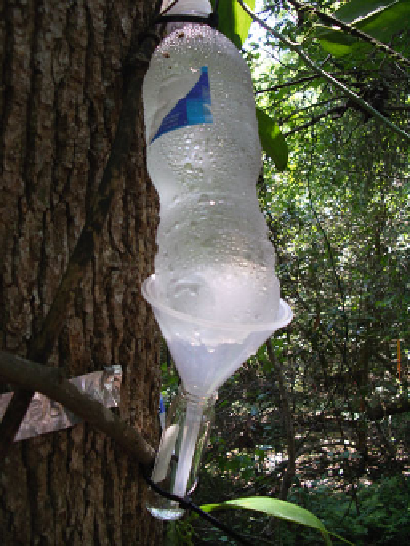Environmental Engineering Reference
In-Depth Information
the TNT, as there was no evidence of mineralization.
Plants can transform TNT by a Phase I reduction into
nitroamine intermediate compounds such as 2-amino-4,
6-dinitrotoluene (Bhadra et al. 1999). These intermediates
can undergo Phase II conjugation and be stored as
unextractable organic matter in the plant tissues. This was
the first study to report evidence suggesting that byproducts
of TNT transformation could be conjugated in plants.
Wayment et al. (1999) investigated the formation of
conjugates in root tissue cultures of various plants exposed
to TNT, including the aquatic plant
M. aquaticum
. They
reported the detection of up to four different TNT
conjugates, which were most likely formed by the addition
of sugars to the amino group of the TNT taken up (Wayment
et al. 1999). Burken et al. (2000) also indicated that the
predominant first detoxification process for TNT can be
an oxidative Phase I to mono-amino derivatives, with
subsequent conjugation to more soluble compounds. These
reactions are not as significant for removal of RDX in plants,
however. To this end, researchers are focusing on engineer-
ing transgenic plants that express the bacterial genes to
produce cytochrome P-450 and reductases that rapidly
remove RDX and TNT from soils and leachate.
Chekol et al. (2002) investigated the fate of TNT applied
to plants grown in soils of two different organic matter
contents in a greenhouse study. The effect of organic content
on TNT fate, by plants, is important. For the plant to interact
with the TNT, the TNT has to be bioavailable rather than
absorbed to the sediment. For the soil that contained 6.3%
organic matter and 100 mg/kg TNT, plants such as the
legumes alfalfa (
Medicago sativa
) and sericea lespedeza
(
Lespedeza cuneata
) and various grass species, less than
1% of the added TNT was recovered in both treatment and
controls. This indicates that the TNT was removed by sorp-
tion. Conversely, for the soils that contained 2.6% organic
matter, higher amounts of TNT were recovered. Also in
these soils, 85% of the initial TNT added was recovered
from the unplanted controls, but only 23% was recovered
from the planted soils. Moreover, the grass species
characterized by a shallower, more dense, fibrous root sys-
tem removed a higher percentage of added TNT relative the
legume species, which are characterized by a deeper tap
root. These results have implications as for what type of
vegetation to install at a site where the contamination has
been delineated as a function of depth.
The fate of explosives compounds in leaves after they fell
was studied by researchers at the University of Iowa (Yoon
et al. 2006). The nitroaromatic compound investigated was
TNT, along with RDX and HMX. These compounds remain
at many Department of Defense sites and other military sites
as a legacy to munitions production since the 1940s (Bradley
et al. 1994). The fate of these explosive compounds in the
presence of plants has been investigated, which showed that
Fig. 13.20
Simple apparatus developed by the author to collect triti-
ated water vapor from the riparian forest growing above tritium-
contaminated groundwater. See Vroblesky et al. (2009) for more infor-
mation (Photograph by author).
first to examine the effect of native plants on the
phytoremediation of tritium-contaminated groundwater in
an arid environment.
The phytoremediation of tritium-contaminated ground-
water in a humid environment was examined by Vroblesky
et al. (2009) near Barnwell, South Carolina. A low-level
radioactive waste-disposal facility resulted in tritiated
water in local groundwater and surface water in a down-
gradient riparian forest that received tritium-contaminated
groundwater discharge. Tree cores were collected and
analyzed for tritium. The sap-flow rate was measured on
some tritium-contaminated trees using the TDP approach.
The results indicate that some trees may remove more than
17.1 million picocuries per day (pCi/day) when transpiration
is high during the growing season. The tritiated water taken
up by the roots is transpired from the leaves, but the tritium
level in air samples, as collected near trees using a simple
apparatus consisting of a frozen water bottle, funnel, and
40-mL VOA vial (Fig
13.20
), did not measure high enough
to create a tritiated-water vapor hazard.
13.6.2 Plant Transformation Reactions
Perhaps the first evidence that plants could take up and
transform TNT was presented by Hughes et al. (1996). In
their study, they hypothesized that the plants first reduced


Search WWH ::

Custom Search